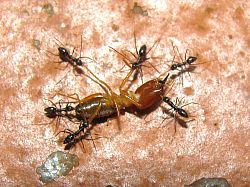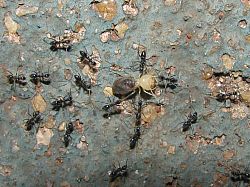Study shows how Crazy Ants catch prey – and keep it
A versatile species of ant – the subject of a new study by University of Sussex biologists – can farm and forage but also hunts co-operatively for food, even providing an escort to prevent live prey from escaping en route to the nest.
 Longhorn Crazy ants dragging dead prey back to the nest, unaccompanied. Photo: Tomer Czaczkes
Longhorn Crazy ants dragging dead prey back to the nest, unaccompanied. Photo: Tomer Czaczkes
 Longhorn Crazy ants dragging live prey back to the nest, accompanied by an 'escort' of guarding ants. Photo: Tomer Czaczkes
Longhorn Crazy ants dragging live prey back to the nest, accompanied by an 'escort' of guarding ants. Photo: Tomer Czaczkes
Dr Tomer Czaczkes and colleagues from Sussex and the University of Saõ Paulo studied the Longhorn Crazy Ant Paratrechina longicornis in Brazil to see how they hunted for prey.
The ants were also presented with live and dead termites and their behaviour was then recorded on video.
The researchers found that the Crazy Ant has a specialised way of calling in re-enforcements identical to that of specialised hunting and scavenging ants.
Crazy Ants lay a chemical trail (known as a ‘pheromone’) from the nest to the site of, for example, a dead insect, which their sisters follow extremely accurately. The chemical trail lasts just a few minutes so that food items or prey can be quickly located and transported by ants that are able to pick up the scent. Lone hunters, meanwhile, can even call in help without returning to the nest, by releasing an attractive chemical into the air.
Once the prey is caught, the ants start co-operatively to carry it back to the nest. When observing the ants carrying back live prey, the researchers saw something unexpected: the ants deploy an ‘escort’ around the captured prey. The escort then guards the prey and helps to recapture it if it escapes its captors.
Dr Czaczkes says: “This escorting behaviour is unique: no one has ever described any other ant doing this.
“Some ants are expert farmers and shepherds, tending flocks of aphids. Other ants are expert hunters and scavengers, with special techniques and strategies for collectively catching prey.
“The Longhorn Crazy Ant is an expert in both. This might be one of the reasons for the ant being so successful.”
Professor Francis Ratnieks, head of the Laboratory of Apiculture and Social Insects (LASI) at Sussex and a co-author of the study, says: “Whenever we study a common ant, whether in Brazil or in Britain, we find out new and amazing things about how the ants in a single colony are able to work together and co-ordinate their activities.
“The results show neatly how ants can tune their trail pheromone to the job it has to do. In the Longhorn Crazy Ant, a single ant who discovers a dead insect can lay a trail strong enough for other ants from its colony to follow to the food item to help drag it back to the nest. Although the pheromone only lasts a few minutes, this is all that is needed.”
